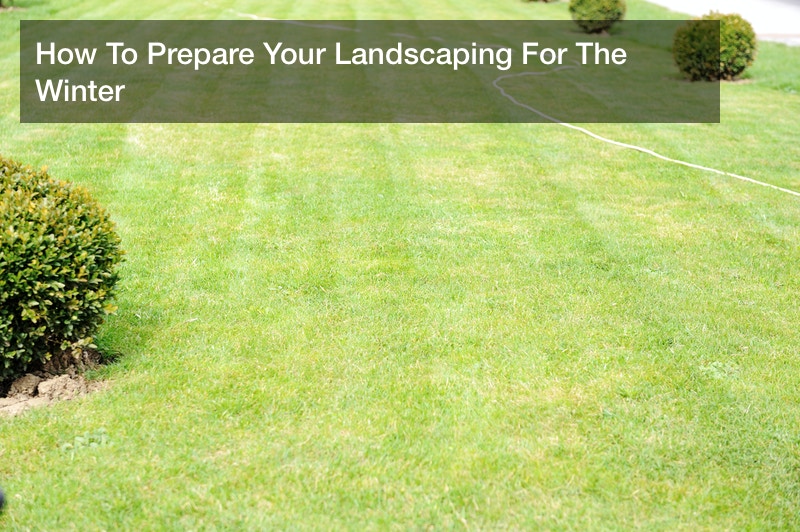
When you talk about winter landscaping, what comes to mind is snow-covered yards and gardens devoid of life. Winter is not too kind to a home’s landscape, and all the aesthetics that make your yard standout will have to be brought inside or covered up.
While most will assume that landscaping your yard is for the warmer times of the year, you can do some maintenance on your yard before the heart of winter descends, either on a DIY basis or by calling several landscaping services to do the job.
Here are some handy tips on how to make sure your landscaping is ready before the cold and snow takes over.
Clean and Sharpen That Garden Equipment

It can be a sad time for landscape lovers, the time when you have to put your tools up for winter. It’s almost enough to make you shed a tear.
While it is a sad moment to put your tools away, make sure you give your garden equipment some last-minute TLC so that those tools can be in prime condition for landscaping once the spring rolls around. Clean and sharpen your equipment to keep them in top shape. You can head to your local garden center to see which tool cleaner they have in stock and will work the best for your yard babies.
Clear Up Rotten Plants

There may not be any doubt that your yard is the envy of the neighborhood. However, even the greenest of thumbs can’t escape the horrors of rotting plants.
Rotting and plants are beyond finished can be a sight for sore eyes and can also attract unwanted insects and creatures. Before winter comes on, pull up and discard your rotting plants. That will send a message to the garden bugs that they must go to another garden to raise their terror campaign. Not only that, but your garden will be ready to go once the weather warms back up.
Prune Trees and Perennials

It’s pretty to have your yard decked out with cute trees, but those trees won’t be so cute if they cause the power to go out in your home or if they die because of the winter cold, so take care of your trees.
Those same pretty trees can cause much damage in a severe winter storm, so before the season rolls around, tree pruning services can come in and prune your trees so your trees won’t be so much of a threat to your power lines. Tree care services make up nearly 6% of the landscaping industry, so you won’t have a hard time finding a professional that can take care of your trees.
While most homeowners will go with pruning their trees, there could be some that may not be worth saving. For this job, get in contact with a tree trimming service that can come in and chop your problem trees down. Much like your tools, trimming a tree down can be hard, but it’s one of the best ways to make your chances high for keeping the lights on if the power fails.
Also, you will want to cut your perennials so they can stay resistant during the winter. Leave your perennials between four-to-six inches tall. There is a time limit, however, for ensuring your perennials stay slaying in your yard for the spring. Cut them before the first frost hit. Cutting your perennials will cause the energy from the top plant to flow into the root system, keeping the plant warm for winter.
Get Your Soil Prepared

After plucking out those rotting flowers, it’s time to ensure that your flower garden will be ready for the spring.<.p>
Fall is often a great time to get your soil prepared for the next season. Enrich your soil so you won’t have to wait until the snowmelt to plant your flowers. There are even some seeds that will grow right in the winter, and this smart technique will get you and keep you ahead of the landscaping game for the winter.
Install Fencing
If there is one annoyance for homeowners, it is people trampling through their perfect yard. To prevent this from happening, install some fencing to protect your yard. Fence installation will cut down folks walking through your yard and keeping it free from outside intruders.
Replenish Mulch
Most homeowners do there mulching in the summer, but you may also want to explore doing this in the winter. Mulching in the winter reduces the loss of water and protects your soil from water. The mulch will also be a barrier for weeds, keeping them out of your yard. Also, doing mulching in the winter will get your garden a head start for the spring. Add a thick layer of mulch so it can moderate the soil temperature and ease your yard into the winter months.
Plant Those Cover Crops
Before you’re done in your yard for the season, plant some cover crops. What are cover crops, you may ask? Well, they’re crops that will help in the battle against soil erosion. Cover crops can also add nutrients to your yard, making it vibrant by the time spring rolls around. Always plant your cover crops a month before the first freeze hits.
Move Those House Plants Indoors
Most outside plants can’t handle the onslaught of winter weather. Any person with a green thumb will tell you it’s a great idea to bring house plants inside for the winter. Most house plants are tropical, and these plants dislike the feel of cold and snow. When you bring your plants indoors to hunker down for a cold winter, hose those plants off to remove the dirt and any bugs and insects that may try to call those plants home for the winter.
Bringing your house plants inside will preserve them and keep them vibrant so that, when the warm air finally returns, you can send them outside to give your home a springy feel.
Clean Out Those Vegetable Beds
If you’re a person with a green thumb that loves to grow vegetables, you will want to make sure that those beds are cleaned just before the first freeze hit. Cleaning out your vegetable bed will prevent those nasty pests from getting into your garden of the oasis. Remove all dead and dying fruit and veggies from your garden. Pick out and remove these dead veggies can cause diseases that can rot your garden to keep disease from spreading.
If you grow tomatoes, clean out the cages with a dilute solution of bleach. Also, rake your garden so you can assure that everything that need not be in your vegetable garden won’t be there.
Keep Your Greenery Conserved
After raking and cleaning your vegetable garden, turn your attention next to your greenery. Rake up all the dead leaves from the plants in your greenery. You can turn your leaves to compost for your yard, which will save you money by not having to purchase compost from the gardening store.
Wave Bye-Bye To Invasive Weeds
Nobody likes to have weeds in their yards. It just gives the landscaping of your yard such a tacky feel. If you have a problem with weeds, make sure you remove them before the first freeze strikes your town.
Dig those invading plant species up and throw them in the nearest trash can. Or, if you live in the country, burn them with the rest of the autumn yard discards. Keep in mind that weeds can be resilient, which is why it’s best to discard them instead of adding them to a weed pile or compost heap.
Make sure your garden doesn’t have any weeds. It’s the only way to keep them from sprouting and doing damage to your spring crop, and your plants won’t be too happy about that.
Let Those Leaves Work For You
With the coming of autumn, you’ll hear the sounds of many rakes putting a yard full of leaves into a pile and put on the curb. Yes, raking leaves is never a fun thing to do, but it’s a vital part of landscaping. However, instead of putting those leaves in a pile and bagging them up, maybe you can put those leaves to work on your yard’s behalf.
You can easily use those leaves as a compost pile, or you can have them turned into mulch, which can get your yard ready for the winter. If you have a yard filled with leaves every autumn, invest in a mulching mower that will break up the leaves and turned into mulch nourishing to your soil.
Get Turf Tough
When you mow your lawn in the fall, there is a way that you should cut it so that your yard will be turf tough for the fall. Cost Farms recommend that you don’t cut your lawn too close. Leave some grass on top so it will build up the strength needed to get through the winter. Feed your yard with cold-season grasses that will make it tougher. If you live in a more moderate climate, also give your yard a fall feeding, which will carry all the same benefits as yards in colder climates.
Make Sure Your Yard Can Drain
You may not think of this while preparing your yard for the winter, but also make sure that it can drain all the precipitation that winter brings its way. Poor drainage can wreak serious havoc on your home, so to assure that you won’t need residential plumbing services during the winter, ensure that the drainage surrounding your home works properly. If poor drainage causes damage to your home, residential plumbers can come in a fix the drainage issue. If you suffer any damage because of it (and we hope you don’t), call a professional that deals with water damage restoration to fix the damage to your property.
In conclusion, having your yard and garden ready for the winter is vital to ensuring you’ll have a happy and vibrant home landscape when spring arrives. Pull up those dying plants so that diseases won’t wreak havoc on your yard. Clean up those gardening tools (we know it’s hard) and get them in shape for landscaping in the spring. Trim your trees back so it won’t be a problem to your power lines and that your trees will flourish when the weather warms up.
Make one more trip to a garden center near you to grab the landscaping products that you will need to get your yard ready for the winter, such as soil and mulch. Speaking of mulch, you may not have to buy that at your local store as a prime source of it will be right there in your front yard in the form of leaves.
Instead, buy a mulching lawnmower so you can use those leaves as mulch for your lawn. Also, make sure you remove dead plants and weeds from your lawn so they won’t cause any damage to it while it’s facing the onslaught of cold and snow.
Your yard is the apple in your eye, the pride, and joy of your home. Much like you would do to your home, having your yard ready for the winter will go a long way to keeping your landscape vibrant and full of life when the birds come back and the sun shines its warm rays again.





